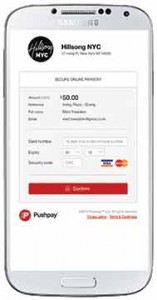
The origins of Pushpay involve a most unlikely element: a bike.
After college graduation, while listening to a challenging sermon via podcast on a training ride, Pushpay co-founder and director Eliot Crowther asked himself a pivotal question — one which so many young people don’t: Will generosity be a part of my life? It was a big moment, personally — and, though, he didn’t know it at the time, for Crowther’s career.
Having spent a decade as a competitive cyclist, Crowther realized he needed to get out of the circuit several years ago while competing overseas. He went back to New Zealand. “I needed an idea,” he recalls.
Crowther prayed for about a year. Then, at a café, he came up with an idea for a smartphone-based giving platform. He took his idea to Chris Heaslip — now Pushpay’s CEO and co-founder — and the two immediately began strategizing the vision of the company and identifying the values the team behind it should have. Then, they prayed.
This is just of several great articles from “Simplifying Giving,” an eBook from Church Executive and Pushpay. Download the eBook — at no cost — here.
In mid-2012, Crowther and Heaslip developed the technology that’s so unique to Pushpay. After downloading the app and making the first gift, any future donations can be made in 10 seconds or less — any time — by smartphone.
Soon after, they rolled out the platform to churches in New Zealand. It was a great test case for Pushpay’s expansion potential.
Within months, Crowther and his family sold their possessions and moved to Irvine, CA, to see what Pushpay could do there — a relocation made even more momentous wh en, the day before departing, they learned they were expecting their second child.
en, the day before departing, they learned they were expecting their second child.
“It was pretty scary going to the other side of the world, but God blessed us,” Crowther says. “The market was very receptive right away. Incredible stuff happened.”
Among the amazing happenings: the employees — most with church backgrounds — who came onboard right away. Among them was Troy Pollock, executive pastor at one of the company’s first church partners. Although Pollock’s church was already generous, implementing Pushpay’s platform ramped up the giving culture in dramatic ways. “Troy came onto the team as a calling from God,” says Marketing Director Fraser Clark. “We’re blown away by his heart, and by our church partners’ reaction to him.” Today, he’s Director of Church Operations at eChurchGiving, the entity which brings the Pushpay platform to U.S. churches.
Like Pollock, all of eChurch’s representatives come from church backgrounds. “Lots of them are still in lay ministry, and many have been church staff,” Clark says. “So, they understand the nuances of how the platform should (and does) work.”
Within a year of setting up shop in California, the company moved its headquarters to Seattle, WA. There, it found an abundance of technology and a “wonderful cultural fit,” according to Crowther.
“We were — and are — in a very privileged position where we could go out and build world-class technology,” he adds. “The church shouldn’t be playing catch-up when it comes to technology, so we’re playing leapfrog instead.”
 Technology built on a vision
Technology built on a vision
The company’s guiding vision is to see the Kingdom of God resourced, equipped and growing through generosity. “That means removing barriers to giving, especially on the first gift,” Crowther says. “We want to make it easy for people to be generous. God isn’t changing, but the world — and technology — are.”
When designing the Pushpay platform, Crowther and his team were intent on overcoming a few challenges inherent to existing tools — beginning with the amount of information required prior to giving. “If people have to fill in a bunch of information first, statistics show that 50 percent to 60 percent of them will abandon the effort,” he points out.
And this isn’t just a hurdle for small and growing churches, he adds: The average online giving experience in the 50 fastest-growing churches in the U.S. is more than three minutes. In contrast, giving via Pushpay requires just a handful of seconds.
“As a result, we’re consistently seeing a significant impact in online giving — often doubling,” Clark says. “We’re also seeing the engagement of new givers. In the future, we want to see $1 billion in new giving raised for the Kingdom.”
One church who can testify to the power of simple giving is The Cause Community Church in Brea, CA, where the platform has been in place for nine months. Originally, Business Administrator Joshua Reeve took a look at Pushpay as a courtesy to a church member.
“But, I could see that it met a need our church had, but didn’t know how to address,” he recalls.
To introduce the tool to the congregation, Reeve and his team showed a video (provided by Pushpay). Then, using the app, the lead pastor made a gift in real-time. The following Sunday, they showed the video again.
Less than a year later, the church has doubled its online transactions. “Previously, 140 transactions per month was great,” Reeve says. “Now,  300 per month is a pretty consistent figure.” Of these, about 80 percent are given using the Pushpay app, and about 10 percent are new givers.
300 per month is a pretty consistent figure.” Of these, about 80 percent are given using the Pushpay app, and about 10 percent are new givers.
Reeve anticipates transactions will grow by an additional 15 percent to 20 percent as pipeline integrations are rolled out in the Pushpay platform, further fortifying the ministry he and his team can offer — the most welcome benefit of all.
To this end, every Sunday, Reeve watches a 50-year-old, longtime church member with cerebral palsy give, independently, with no assistance.
“He loves the Lord, but he could never participate in the offering on his own before,” he explains. “Now, in a matter of seconds, he can take out his phone and give. It lets him really be a part of the worship service.”
— Reporting by RaeAnn Slaybaugh
The Cause Community Church (Brea, CA)
How simplifying giving is freeing up valuable staff time for ministry
 Once upon a time at The Cause Community Church in Brea, CA — as with so many churches — giving online required creating a unique login and filling out a litany of details first. “This time-intensiveness was always on the back of my mind,” recalls Business Administrator Joshua Reeve.
Once upon a time at The Cause Community Church in Brea, CA — as with so many churches — giving online required creating a unique login and filling out a litany of details first. “This time-intensiveness was always on the back of my mind,” recalls Business Administrator Joshua Reeve.
So, Reeve decided to mobilize the Pushpay app-based mobile-giving platform. But, first things first: he needed to familiarize his staff with the new tool.
“We explained why it was chosen — in particular, the administrative benefits,” Reeve recalls. What he told the team ultimately conspired: Less processing time was required, freeing up their time for ministry projects.
 A database integration feature with the church’s management system, Fellowship One, made it possible.
A database integration feature with the church’s management system, Fellowship One, made it possible.
This integration — performed by the Pushpay team, with the church’s permission — meant staff didn’t have to re-enter members’ information. Now, when someone makes a gift, the platform attempts to match that gift to an existing record using the donor’s email address.
About 80 percent to 90 percent of transactions merge immediately. If a donor isn’t in the church’s database, a new record is created.
“People are really processing their own donations at this point,” Reeve says.
RELATED RESOURCES:


